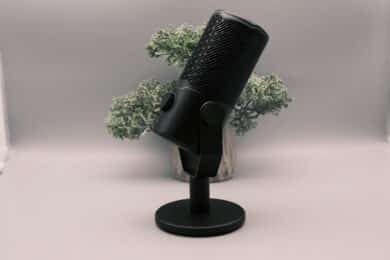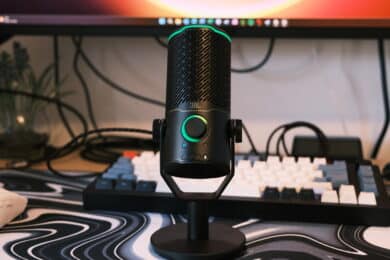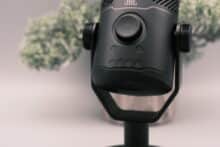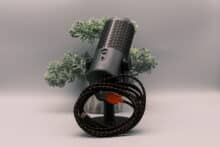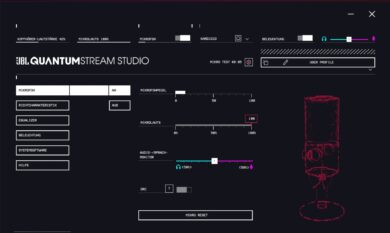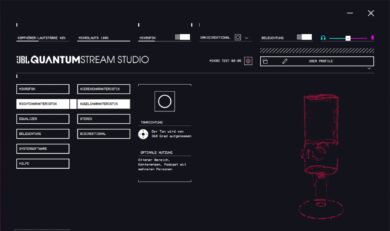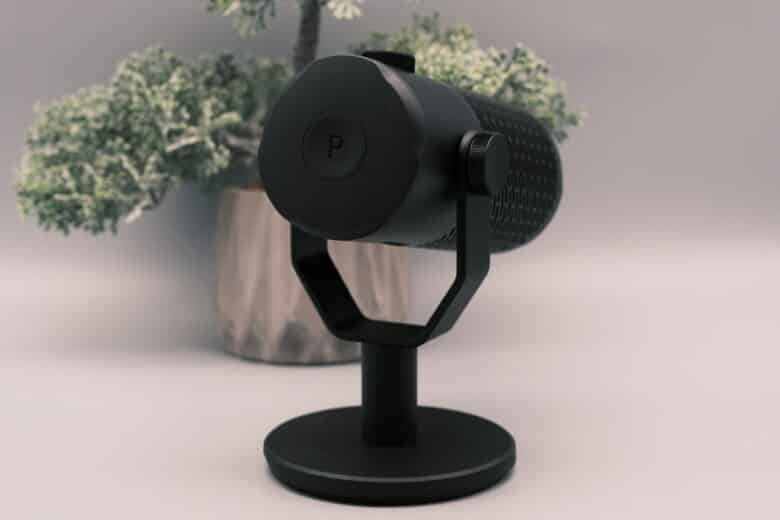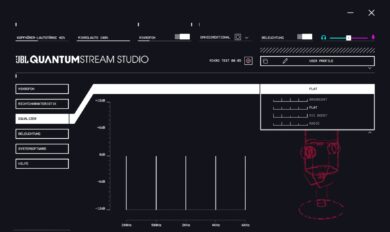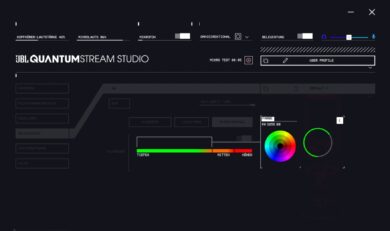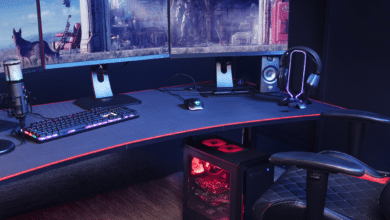
With the JBL Quantum Stream Studio, the manufacturer is launching a new USB microphone that aims to score points with its versatile options and RGB lighting. The special feature: the mic offers four voice recording patterns that can be switched between at the touch of a button. Find out how good it sounds and whether it’s worth buying in our test.
Technical data
| Product: | Quantum Stream Studio |
| Connection: | USB Type-C |
| Microphone diaphragm: | 14 mm (condenser) |
| Frequency response: | 50 Hz – 16,000 Hz |
| Sampling rate: | 192 kHz / 24 bit |
| Polar pattern: | Cardioid, omnidirectional, stereo, bidirectional |
| SPL: | 110 dB |
| Dimensions (incl. stand): | 210 mm x 87 mm (height x depth) |
| Weight: | 558 grams (with stand) |
| Connections: | USB-C; 3.5 mm jack |
| Special features: | RGB lighting; mute button; multifunctional control button; four directional characteristics |
| Price: | € 119.00 * |
JBL Quantum Stream Studio Test: Design and workmanship
- Discreet, customizable RGB lighting
- elegant design
- convincing workmanship
USB microphones are now a dime a dozen. It feels like every manufacturer wants a slice of the pie. With the JBL Quantum Stream Studio, the manufacturer is now launching a new model on the market that expands on the Quantum Stream (without studio) that has been available for some time.
The new microphone weighs 558 grams including the stand and is 21 centimeters high. This makes it not only heavier, but also larger than the Cherry XTRFY Ngale R, which we recently tested.
What connects the two microphones – in addition to the USB-C port for the connection – is RGB lighting. However, this is very discreet on the JBL model and only extends to a light strip on the top and a light ring around the generous gain control in the middle.
The effects are freely customizable within the software. In addition to static lighting, there are all kinds of color-changing effects whose colors, intervals and lighting duration can be adjusted to your own taste. The fact that the ring around the gain control indicates when the microphone is picking up sounds and also displays the set volume proves to be very practical.
Also practical: the JBL Quantum Stream Studio is muted via the capacitive mute button on the top, the upper illuminated ring then signals in red that no recording is taking place. Unfortunately, the touch surface is not really responsive. You have to press quite firmly on it for it to react.
There are also two LEDs on the front that tell you whether you are adjusting the volume of the connected headphones or the microphone. Below this, there are four more LEDs that provide information about the currently selected recording pattern, but more on this later.
The JBL Quantum Stream Studio is connected at the rear. It connects to a PC or notebook via USB-C, while headphones can be used for monitoring via a 3.5 mm jack. A generous, fabric-covered USB-C to USB-A cable is conveniently included with the microphone.
The workmanship of the microphone, which is made of plastic, gives no cause for criticism and does justice to the price. If you prefer, you can simply unscrew the integrated stand and use the Quantum Stream Studio on a microphone boom.
Setup, software and practice
- Plug and play
- Many settings in the software
- Dedicated button for changing the directional characteristic
The JBL Quantum Stream Studio is immediately ready for use thanks to plug-and-play connectivity. After plugging it in, a pop-up window informs us that we should ideally download and install the JBL QuantumEngine software in order to make full use of the microphone’s possibilities. Of course we agree.
We already know the software with its futuristic but not necessarily clear design from headsets such as the Quantum 910 (our test). The size of the window is still not customizable and the font is not necessarily ideal for higher resolutions. But that’s fine.
At the top edge you will find a bar that provides information about the most important settings such as volume, mute, lighting or balance. The menu on the left-hand side offers a number of setting options.
The first item, next to switching on and off, is the polar pattern. This is a special feature of the JBL Quantum Stream Studio, as there are four options to choose from:
- Cardioid (sound is picked up from 180 degrees)
- Omnidirectional (sound is picked up from 360 degrees)
- Stereo (sound is picked up from the left and right)
- Bidirectional (sound is recorded from the front and rear)
Conveniently, the app even tells you which directional characteristic is particularly suitable for which scenario. So for podcast recordings, conferences, recording musical instruments and more.
You can also switch between the four polar patterns at the touch of a button. There is a “P” button on the underside of the microphone that allows you to switch. The LEDs on the front indicate which setting is currently active.
It is also possible to influence the sound using the 5-band equalizer. If you don’t want to play around manually, you can also choose between one of four EQ presets: Flat, Broadcast, Mic Boost or Radio, which noticeably change the acoustics of the microphone.
In the “Lighting” section, you can then customize the RGB lighting, change the brightness or even deactivate the lighting completely if you wish.
Sound quality of the JBL Quantum Stream Studio
- 192 kHz at 24 bit
- quite neutral sound
- sharp S-sounds somewhat exaggerated
The JBL Quantum Stream Studio covers a frequency response of 50 Hz to 16,000 Hz and uses three built-in electret condenser microphones with a diameter of 14 millimeters. The microphone allows a maximum recording in 192 kHz at a bit rate of 24 bits. These are strong values, although the capsule is rather small.
In terms of sound, of course, it makes a noticeable difference which directional characteristic you select and which equalizer setting you choose. Basically, I would describe the sound as good, although the mic does exaggerate sharp S and plosive sounds a little, especially in the highs, and presents the voice more neutrally than many other microphones.
JBL Quantum Stream Studio microphone test recording:
Cherry XTRFY Ngale R microphone test recording:
ASUS ROG Carnyx microphone test recording:
I find it lacks a certain warmth. Some competitors in this price segment sound a bit fuller and rounder, but the JBL microphone basically delivers a good sound. Background noise is filtered out relatively well in cardioid mode, but also comes through a little more here.
You can listen to how the different equalizer modes sound here:
As you can already hear here, the equalizer has a noticeable effect on the sound. I like the “Mic Boost” setting best, which makes the voice sound fuller and warmer. However, this depends on personal preference, but also on your own voice.
JBL Quantum Stream Studio Test: Conclusion
The JBL Quantum Stream Studio is a successful USB microphone that combines a classy look with good workmanship and appealing, albeit restrained, RGB lighting.
A real special feature is the four adjustable directional characteristics, thanks to which the microphone can be adjusted for different scenarios. Something that I have never seen in this form from any other manufacturer.
In terms of sound, the microphone also cuts a good figure, but some competitors in this price range reproduce the voice warmer and fuller.
JBL Quantum Stream Studio
Workmanship
Recording quality
Features
Value For Money
89/100
Convincing USB microphone with good sound, four directional characteristics and stylish RGB lighting.

